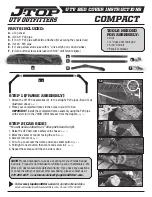
RXW Multi-Depth Soil Moisture Sensor (RXW-GPx-xxx) Manual
1-800-LOGGERS
9
www.onsetcomp.com
•
Make sure the interior seal is intact and free of any debris,
and the latches are fully locked when the mote door is
closed.
Removing the Sensor from the Soil
To remove a sensor probe from the soil:
1.
Carefully dig out the soil around the top of the probe with a
hand shovel, being sure not to damage the probe or cable.
Dig out the hole until at least 30 cm (11.8 inches) of the
probe is exposed.
2.
Grasp the probe firmly with two hands as you pull it
upwards. Do not grab onto the black probe head as it is not
secured with enough strength for probe extraction. Do not
pull the probe up by the sensor cable.
Updating Mote Firmware
If a new firmware version is available for the mote, use
HOBOlink to download the file to your computer.
1.
In HOBOlink, go to Devices, then RX Devices, and click your
station name.
2.
On the station page, click Overview and scroll down to
Device Information.
3.
Click the Wireless tab. This icon
appears next to the
mote if there is a new version of firmware available.
4.
Click the firmware
upgrade link. Click Download and
save the firmware .bin file to your computer.
5.
Connect the mote to the computer with a USB cable (open
the mote door and use the USB port to the right of the
LCD). The blue LED is illuminated while connected.
6.
The mote appears as a new storage device in the
computer’s file storage manager. Copy the downloaded
firmware file to the new storage device (the mote). The
blue LED will blink slowly while the file is copying.
7.
After the file is copied to the mote, the LED will stop
blinking and remain a steady blue. Eject the storage device
from the computer and disconnect the cable from the
mote. The firmware installation process will begin
automatically on the mote. The blue LED will blink rapidly
while the firmware is installed. Once the firmware
installation is complete, the LCD symbols return and the
mote will automatically rejoin the network.
Notes:
•
Mac® users: A message may appear indicating the disk
has not ejected properly when disconnecting the mote
from the computer. The mote is operational and you can
ignore the message.
•
If the blue LED turns off abruptly while copying the file or
installing the firmware, a problem has occurred. Contact
Onset Technical Support for help.
Battery Information
The mote uses two 1.2 V rechargeable NiMH batteries, charged
by the built-in solar panel. The quality and quantity of solar
light can affect whether the battery is sufficiently charged to
last through the night and cloudy periods. Make sure the mote
is placed in a location that will receive several hours of sunlight
each day. If the mote does not receive enough sunlight to
recharge the batteries, the battery life is estimated at 3–4
months. When batteries are regularly recharged, expected
battery life is estimated at 3–5 years. Battery life varies based
on the ambient temperature where the mote is deployed, the
logging interval, the number of tripped alarms, and other
factors. Minimum recommended logging intervals as described
in the specifications should be followed to keep the batteries
charged. Deployments in extremely cold or hot temperatures
can impact battery life. Estimates are not guaranteed due to
uncertainties in initial battery conditions and operating
environment.
Mote operation will stop when battery voltage drops to 1.8 V.
Mote operation will return if the battery recharges to 2.3 V. If
the batteries are unable to be recharged, replace them with
fresh rechargeable batteries.
Note:
if you install used
rechargeable batteries that together are less than 2.3 V, the
mote will not resume operation.
To replace rechargeable batteries:
1.
Open the mote door.
2.
Remove the old batteries and install fresh ones observing
polarity.
3.
Make sure the solar panel cable is plugged in.
The mote contacts the network once the new batteries are
installed. The green LED blinks quickly while the mote searches
for a network to join and then blinks slowly while it completes
the network registration. Once the mote has finished joining
the network, the green LED turns off and the blue LED then
blinks indefinitely while the mote is part of the network.
Lithium Batteries
You can use two 1.5 V non-rechargeable lithium batteries
(HWSB-LI) for operation at the extreme ends of the mote
operating range. The estimated battery life is one year with a
minimum logging interval of 10 minutes for the RXW-GP3-xxx
model or 15 minutes for the RXW-GP4-xxx model. The
estimated battery life for the RXW-GP6-xxx model is seven
months with a logging interval of 15 minutes. In addition,
battery life is based on the ambient temperature where the
mote is deployed, the number of tripped alarms, and other
factors.
Estimates are not guaranteed due to uncertainties in
initial battery conditions and operating environment. When
using lithium batteries, you must disconnect the solar panel
cable because the batteries will not be recharged.
To install lithium batteries:
1.
Open the mote door.
2.
Remove any old batteries and install the new ones
observing polarity.
3.
Push in the side tab of the solar panel cable connector and
pull the connector out of the cable port.
Make sure
solar panel
cable is
installed
when using
rechargeable
batteries




























